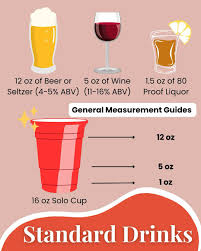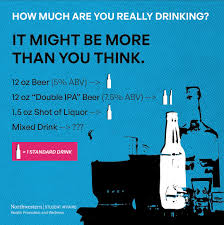Why Are a 12 Ounce Hard Seltzer and 1.5 Ounces of Liquor Both Standard Drinks? Understanding Alcohol Equivalency



Chính Sách Vận Chuyển Và Đổi Trả Hàng
Miễn phí vận chuyển mọi đơn hàng từ 500K
- Phí ship mặc trong nước 50K
- Thời gian nhận hàng 2-3 ngày trong tuần
- Giao hàng hỏa tốc trong 24h
- Hoàn trả hàng trong 30 ngày nếu không hài lòng
Mô tả sản phẩm
The world of alcoholic beverages is vast and varied, offering everything from crisp beers and fine wines to potent spirits and trendy hard seltzers. Despite their differences in taste, presentation, and perceived strength, many seemingly disparate drinks contain the exact same amount of pure alcohol and are therefore considered a “standard drink.” This concept often leads to confusion, particularly when comparing a 12-ounce hard seltzer to a mere 1.5-ounce shot of liquor. The simple, underlying truth is that both are defined as a standard drink because they contain approximately 0.6 fluid ounces (or 14 grams) of pure ethanol. This equivalency is not about the volume of the liquid but the precise quantity of alcohol it delivers, a critical distinction for understanding responsible consumption, health guidelines, and legal limits.
This article will delve into the precise definition of a standard drink, break down the alcohol content in hard seltzers and distilled spirits, explore other common alcoholic beverages through this lens, and explain why this standardized measurement is fundamental to health, safety, and informed choices when consuming alcohol.
The Foundational Concept: Defining a "Standard Drink"
To truly grasp why a 12-ounce hard seltzer and a 1.5-ounce pour of liquor are considered equivalent, we must first establish a clear understanding of what a "standard drink" actually is. Across the United States, health organizations like the Centers for Disease Control and Prevention (CDC) and the National Institute on Alcohol Abuse and Alcoholism (NIAAA) define one standard drink as any beverage containing 0.6 fluid ounces or 14 grams of pure alcohol (ethanol). This standardized measurement acts as a universal yardstick, allowing individuals and public health bodies to consistently track and communicate alcohol intake regardless of the type of beverage being consumed.
Why a Standardized Definition Matters
The necessity of a standard drink definition arises from the wide variation in alcohol concentrations across different types of alcoholic beverages. Without such a standard, it would be incredibly difficult for individuals to monitor their consumption, for healthcare professionals to provide consistent guidance, or for researchers to conduct studies on alcohol's effects. It transforms a complex array of drinks into a measurable, comparable unit, simplifying public health messaging and empowering individuals to make informed decisions about their alcohol intake. This uniformity is crucial for setting national drinking guidelines, understanding the risks associated with excessive consumption, and interpreting legal thresholds like Blood Alcohol Content (BAC) limits.
The Case of the 12-Ounce Hard Seltzer
Hard seltzers have rapidly grown in popularity, often marketed as a lighter, more refreshing alternative to traditional beers or sugary cocktails. Their appeal frequently lies in their typically lower calorie count and often fruit-infused flavors. However, the perception that they are "lighter" can sometimes lead to the misconception that they contain less alcohol per serving than other beverages. This is where the standard drink definition becomes particularly important.
Calculating Alcohol Content in Hard Seltzers
Most hard seltzers sold in 12-ounce cans contain an Alcohol By Volume (ABV) of approximately 5%. To determine the pure alcohol content, a simple calculation is applied:
- Volume of drink: 12 fluid ounces
- Alcohol By Volume (ABV): 5% (or 0.05)
- Pure Alcohol Content = Volume of drink × ABV
- Pure Alcohol Content = 12 fl oz × 0.05 = 0.6 fl oz
As this calculation clearly shows, a typical 12-ounce hard seltzer indeed contains 0.6 fluid ounces of pure alcohol, perfectly aligning it with the definition of one standard drink. Despite its effervescent nature and often subtle flavor, the intoxicating component is present in the exact same quantity as in other standard servings.
The Potency of 1.5 Ounces of Liquor
Distilled spirits, commonly referred to as liquor, encompass a wide range of beverages such as vodka, whiskey, gin, rum, and tequila. These drinks are known for their higher alcohol concentration compared to beer or wine, which is why their standard serving size is significantly smaller.
Understanding Liquor's Alcohol Content and "Proof"
The standard serving size for liquor is 1.5 fluid ounces, which is often measured by a shot glass or a jigger in a mixed drink. The typical ABV for most common liquors is 40%, although some variations exist. Alcohol content in spirits is also frequently expressed as "proof," where proof is simply twice the ABV percentage (e.g., 80 proof means 40% ABV).
Calculating Pure Alcohol in Liquor
Applying the same formula to a standard pour of liquor reveals its pure alcohol content:
- Volume of drink: 1.5 fluid ounces
- Alcohol By Volume (ABV): 40% (or 0.40)
- Pure Alcohol Content = Volume of drink × ABV
- Pure Alcohol Content = 1.5 fl oz × 0.40 = 0.6 fl oz
Just like the hard seltzer, a 1.5-ounce serving of 80-proof liquor also delivers 0.6 fluid ounces of pure alcohol. This direct equivalence, despite the vast difference in liquid volume, is the core reason both are considered a single standard drink.
Other Common Alcoholic Beverages and Their Standard Drink Equivalents
To further illustrate the consistency of the standard drink concept, it's helpful to look at other popular alcoholic beverages:
- Regular Beer: A 12-ounce can or bottle of regular beer typically has an ABV of around 5%. (12 fl oz × 0.05 = 0.6 fl oz pure alcohol). This is why a 12oz beer is also a standard drink.
- Wine: A standard serving of wine is generally considered to be 5 fluid ounces, with an average ABV of 12%. (5 fl oz × 0.12 = 0.6 fl oz pure alcohol).
- Malt Liquor: Often coming in larger containers, an 8 to 9-ounce serving of malt liquor (which can have an ABV of around 7%) constitutes one standard drink.
These examples reinforce the idea that the physical volume of a drink can be misleading. It is the percentage of alcohol by volume, combined with the serving size, that ultimately determines how many standard drinks are being consumed.
The Underlying Science: Alcohol Metabolism and the Standard Drink
The consistent definition of a standard drink isn't arbitrary; it's rooted in the science of how the human body processes alcohol. The liver metabolizes alcohol at a relatively constant rate, typically about one standard drink per hour. This rate can vary slightly depending on factors such as a person's weight, gender, metabolism, and whether food has been consumed, but the fundamental principle remains: the body can only process a certain amount of pure alcohol over time.
When you consume alcohol, it is absorbed into your bloodstream and then primarily broken down by enzymes in the liver. Regardless of whether that 0.6 ounces of alcohol came from a hard seltzer, a shot of whiskey, or a glass of wine, the liver faces the same task of processing that specific quantity of ethanol. Understanding the standard drink helps individuals gauge how quickly their Blood Alcohol Content (BAC) might rise and how long it will take for alcohol to leave their system. This direct link between the standard drink unit and the body's metabolic capacity underscores its importance for health and safety.
Why Understanding Standard Drinks Matters for Health and Safety
Knowing that a 12-ounce hard seltzer and a 1.5-ounce shot of liquor are both standard drinks is not just a trivia fact; it's vital for a multitude of reasons concerning personal health, public safety, and legal compliance.
Promoting Responsible Consumption and Health Guidelines
Public health guidelines, such as those from the Dietary Guidelines for Americans, recommend limiting alcohol consumption to specific daily and weekly amounts (e.g., up to one drink per day for women and up to two drinks per day for men). These recommendations are always expressed in terms of "standard drinks." Without a clear understanding of what constitutes a standard drink, individuals might unknowingly exceed these guidelines, putting themselves at risk for:
- Binge Drinking: Defined as consuming 4 or more standard drinks for women, or 5 or more for men, on a single occasion. This practice significantly increases health risks.
- Alcohol Poisoning: A severe and potentially fatal consequence of consuming large amounts of alcohol rapidly.
- Long-Term Health Issues: Chronic heavy drinking contributes to liver disease (cirrhosis), heart conditions, certain cancers, weakened immune systems, and mental health disorders.
By accurately tracking standard drinks, individuals can make informed choices to stay within recommended limits and mitigate these risks.
Legal Implications: Driving and Public Safety
Laws related to alcohol consumption, particularly those concerning driving under the influence (DUI/DWI), are directly tied to BAC levels. Your BAC is determined by the amount of pure alcohol in your bloodstream. Since each standard drink contributes a predictable amount of pure alcohol, understanding standard drinks helps individuals estimate their BAC and avoid impaired driving. Misjudging the alcohol content of a hard seltzer because of its volume or perceived lightness could lead to severe legal consequences and endanger lives.
Empowering Personal Responsibility
Ultimately, the standard drink concept empowers individuals to take responsibility for their alcohol intake. It shifts the focus from misleading labels or appearances to the actual intoxicating agent. This knowledge allows people to plan their consumption, understand their limits, and make choices that align with their personal health goals and safety concerns.
Addressing Common Misconceptions and Challenges
Despite the clarity of the standard drink definition, several misconceptions persist:
- "Light" Doesn't Mean Less Alcohol: Many "light" beers or seltzers are designed for lower calories or carbs, but their ABV might still be around 5%, making a 12-ounce serving a standard drink. Always check the label.
- Stronger Beverages Require Smaller Servings: Some craft beers, wines, or specialty spirits have higher ABVs (e.g., a beer with 8% ABV). For these, a standard drink will be a smaller volume than the typical 12-ounce or 5-ounce pour. For example, an 8.5-ounce pour of an 8% ABV beer equals one standard drink.
- Mixed Drinks are Tricky: Cocktails often contain multiple shots of liquor, meaning a single mixed drink can easily constitute 2 or even 3 standard drinks. The added mixers can mask the alcohol content.
- The "I Feel Fine" Fallacy: How one "feels" after consuming alcohol is not an accurate indicator of impairment or BAC. The body's processing of alcohol is a physiological constant, regardless of perception.
These challenges highlight the ongoing need for public education regarding alcohol content and the importance of reading beverage labels carefully to ascertain ABV.
Conclusion: The Equalizing Power of Pure Alcohol
In summary, the reason why a 12-ounce hard seltzer and 1.5 ounces of liquor are both considered standard drinks boils down to a single, unifying principle: each contains approximately 0.6 fluid ounces (or 14 grams) of pure alcohol. This standardized measurement transcends the volume, taste, or perceived strength of different alcoholic beverages, providing a consistent metric for understanding alcohol intake.
By defining a standard drink as a specific quantity of pure alcohol, health organizations offer clear guidelines for responsible consumption, enabling individuals to monitor their intake effectively. This knowledge is not merely academic; it is a fundamental tool for making informed decisions about health, avoiding harmful drinking patterns like binge drinking, and ensuring public safety by preventing impaired driving. Whether you're enjoying a refreshing hard seltzer or a carefully crafted cocktail, remembering the underlying equivalency of their alcohol content is key to responsible and enjoyable consumption.